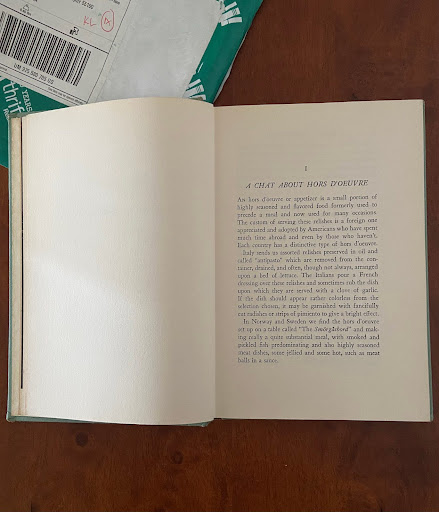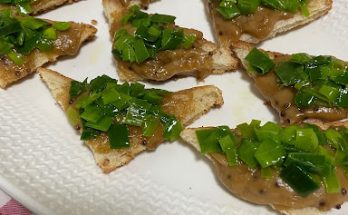
9th April 2024
By Sharmini Jayawardena
Today, I’m going to show you the unwrapping of A Book Of Hors D’oeuvre by Lucy G. Allen, that came to me all the way through Dallas, Texas and Chicago, via the US Postal Service.
It took a very long time to reach me from the time I made the online purchase. I guess they had to search for it as it was the last copy available according to Amazon, and I am the lucky recipient of this wonderful book.
So, here it is !

*

*

It is a hardcover book which is also quite aged as it was first published in 1925 by Little, Brown And Company and this revised edition, published by Bramhall House, New York, in 1941. The jacket is naturally aged and I am going to remove the dust jacket from the book, before reading it. (But of course, I couldn’t resist delving right into the book just as soon as I unwrapped it !!).
*

Front flap of the jacket.
*

Back flap of the jacket
*

Back of the jacket
*

*

*

I just sat there and read through the first few pages of the book, and I find, without my knowledge, I had been observing the principles of creating and serving Hors d’oeuvre just as it appears in the book. Amazing !
And, here are its’ contents:
*

*

*

CONTENTS
I A Chat about Hors d’Oeuvre 3
II Hors d’Oeuvre Foods and Garnishes; to Make canapes 7
A List of Foods Used for Hors d’Oeuvre 7
Types of Hors d’Oeuvre 13
To Make Canapes 15
Garnishes for Hors d’Oeuvre 18
Accompaniments for Hors d’Oeuvre 20
III Flavored Butters 21
IV Canapes for Cocktails 27
Fish 28
Meats 41
Cheese 50
Miscellaneous 56
V Pierced Savories 59
Fish 60
Meat 64
Cheese 68
Miscellaneous 71
VI Hors d’Ouevre for the Compartment Dish 75
Dry Savories 75
Moist Savories 80
VII Spreads for Self Service 89
VIII First-Course or Table Hors d’Oeuvre 97
IX Miscellaneous Recipes 108
Dressings 116
X Varied Combinations for Serving Hors d’Oeuvre 120
Centerpieces for Platters of Hors d’Oeuvre 120
Centerpieces for Pieced Savories 122
Platter Arrangements of Hors d’Oeuvre 125
Tray Combinations for Assorted Canapes 128
Index 133
*

I
A CHAT ABOUT HORS D’OEUVRE
‘An hors d’oeuvre or appetizer is a small portion of highly seasoned and flavored food formerly used to precede a meal and now used for many occasions. The custom of serving these relishes is a foreign one appreciated and adopted by American who have spent much time abroad and even by those who haven’t. Each country has a distinctive type of hors d’oeuvre.
Italy sends us assorted relishes preserved in oil and called “antipasto” which are removed from the container, drained, and often, though not always, arranged upon a bed of lettuce. The Italians pour a French dressing over these relishes and sometimes rub the dish upon which they are served with a clove of garlic. If the dish should appear rather colorless from the selection chosen, it may be garnished with fancifully cut radishes or strips of pimiento to give a bright effect.
In Norway and Sweden we find the hors d’ourvre set up on a table called “The Smorgasbord” and making really a quite substantial meal, with smoked and pickled fish predominating and also highly seasoned meat dishes, some jellied and some hot, such as meat balls in a sauce.
… ‘
I had already made the Italian antipasto by the time the book reached me. I had thought of the Swedish Smorgasbord as well and even the charcuterie, (although I have not found this being mentioned in the book as yet.). I had in mind to create a German appetizer in the form of a bratwurst and red cabbage as mentioned here: “The Germans use various kinds of sausage and … shredded vegetable, …”.
“ … the less heavy ones frequently take the place of sandwiches at afternoon teas, …”.
“The very first requisite for making successful appetizers is imagination, plus whatever happens to be on the shelves of the refrigerator or the pantry.”
(I add to this, to include certain items that may need to be bought as well).
“As most canapés and hors d’oeuvre are best made at the eleventh hour and since that hour is apt to be the busiest one of the day, the popular hors d’oeuvre are those which can be prepared in the briefest period of time.”
I would like to share two recipes from the book.
(Possibly one of caviar and one of sardines which resembles what my mother used to put together especially when guests appeared unannounced to our home.)
BROILED SARDINES (Hot)
Cut bread in finger-shaped pieces just a bit larger than the sardines. Toast lightly and spread with butter creamed with a little lemon juice. Place the pieces of toast one on another and keep covered in a warm place until the sardines are prepared. Select large, boneless sardines and broil over coals. Place one on each piece of toast and garnish with a section of lemon sprinkled with chopped parsley.
(Page 38)
CAVIAR
Caviar should be kept on ice for three hours before serving. It should be seasoned with lemon juice and cayenne or passed with quarters of lemon and cayenne. As metal affects the flavor of caviar it is best to use a wooden fork or spoon for mixing. It may be served on toast, from a block of ice, in a stuffed egg or on a slice of egg, and also from a dish. In the latter case, a small dish containing minced, hard-boiled egg and one of finely chopped onion are also passed. Be sure that the caviar is very cold and the toast to accompany it very hot and dry.
(Page 9)
CAVIAR CANAPÉS III
Cut bread in rounds and toast until crisp. Spread each round with seasoned caviar and over that sprinkle sifted yolk of hard-boiled egg. On the outside edge set three slices from a pimiento-stuffed olive, arranging them at equal distance from each other.
(Page 29)
I must say, the book is as delightful a read as is the information on how to prepare the delightful morsels contained within it.



 TOAST WITH TOMATO
TOAST WITH TOMATO
